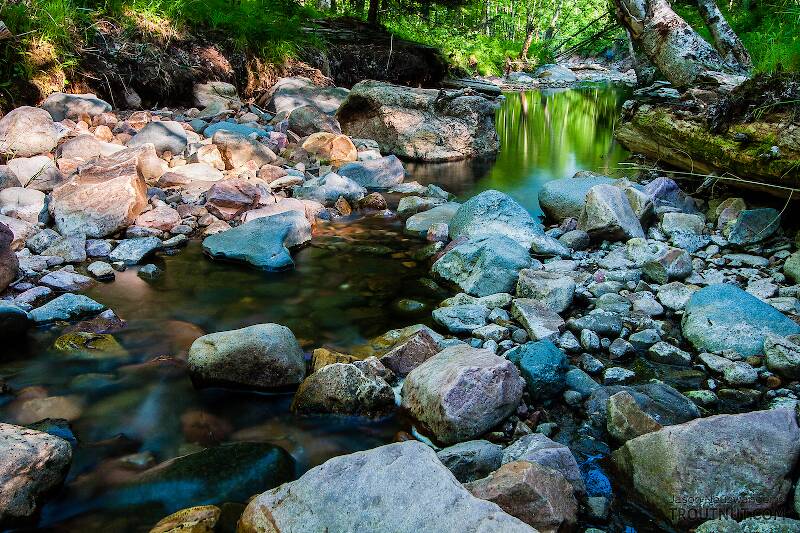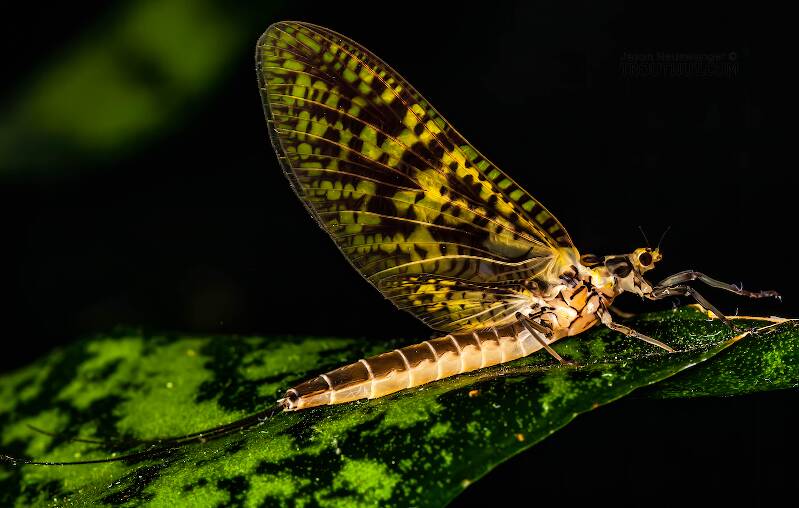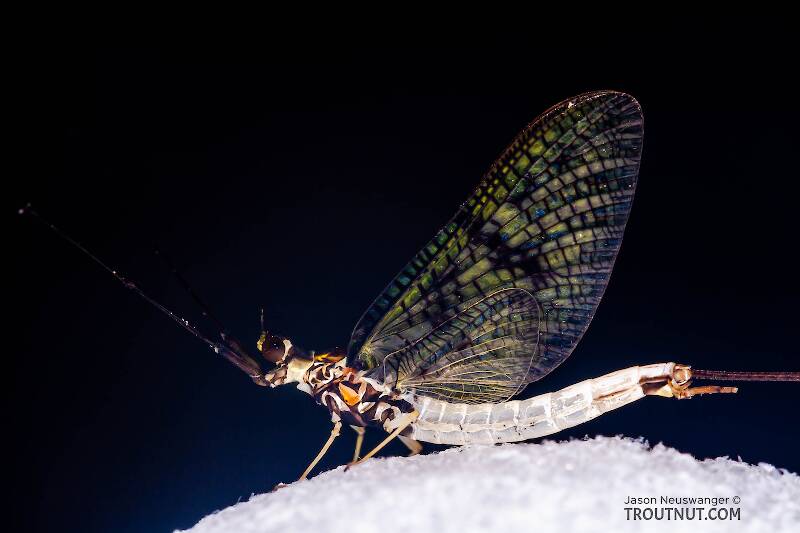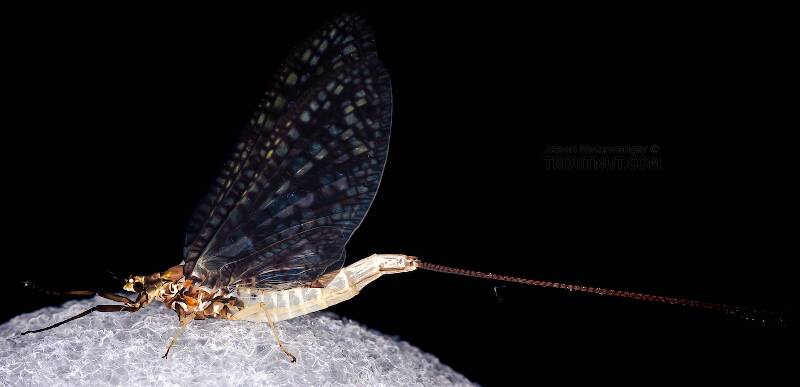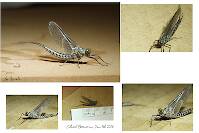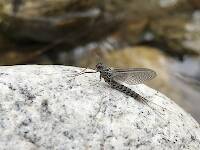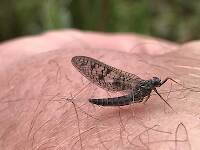
Hex Mayflies
Hexagenia limbata
The famous nocturnal Hex hatch of the Midwest (and a few other lucky locations) stirs to the surface mythically large brown trout that only touch streamers for the rest of the year.
Featured on the forum


Troutnut is a project started in 2003 by salmonid ecologist Jason "Troutnut" Neuswanger to help anglers and
fly tyers unabashedly embrace the entomological side of the sport. Learn more about Troutnut or
support the project for an enhanced experience here.
This topic is about the Mayfly Species Ephemera guttulata
Ephemera guttulata's size, numbers, and hatching characteristics have made it a favorite of fly fishermen since the sport first came to North American waters.It is on par with the Midwest's Hexagenia limbata hatch for its ability to lure huge piscivorous brown trout to eat insects at the surface once a year. The special charm of the Green Drake hatch is that it often takes place during pleasant spring afternoons. It can be challenging because the large flies are easy for trout to inspect in the daylight and they feed very selectively, especially late in the hatch. The huge difference in appearance between green drake duns and the spinners, white-bodied "coffin flies," makes them a peculiarity among major hatches.
The Green Drakes are on the decline due to environmental degradation.
Example specimens
Beardius
Posts: 19
Posts: 19
Beardius on Aug 1, 2008August 1st, 2008, 7:16 am EDT
Emergence periods for green drakes usually run for 7-10 days in most streams. However, there are streams in the east where emergence periods are prolonged by some of the nymphs being parasitized by Nanocladius and Epoicocladius midge larvae. In these streams, emergence may be prolonged to 21 days. Unparasitized nymphs emerge before parasitized nymphs, with each group showing separate peaks of emergence about a week apart. This is based upon my own research on green drake emergence in streams with these midge species.
My question here is this: does anybody know of streams that have this type of prolonged emergence (2-3 weeks) in NY, PA, MD, or WV?
My question here is this: does anybody know of streams that have this type of prolonged emergence (2-3 weeks) in NY, PA, MD, or WV?
Wbranch on Aug 3, 2008August 3rd, 2008, 1:05 am EDT
Yes, the WB of the Delaware in NY has a prolonged emergence period not only for guttalata but for many mayflies. I will see Ep varia on the lower end of the WB by the third week of April and will see them still emerging near the reservoir by May 15 with a spinner fall the next week.
I often see Green Drakes emerging by my cabin on the lower WB by May 20 - 23 then when the hatch is over on the lower river I will see them in Deposit or the upper East Branch almost to the middle of June.
I often see Green Drakes emerging by my cabin on the lower WB by May 20 - 23 then when the hatch is over on the lower river I will see them in Deposit or the upper East Branch almost to the middle of June.
Catskill fly fisher for fifty-five years.
Beardius
Posts: 19
Posts: 19
Beardius on Aug 15, 2008August 15th, 2008, 7:55 am EDT
I'm talking about emergence periods at a specific location. Emergence will vary over the length of a stream depending upon the thermal regime differing over the length of a stream.
Wbranch on Sep 29, 2008September 29th, 2008, 9:05 pm EDT
"My question here is this: does anybody know of streams that have this type of prolonged emergence (2-3 weeks) in NY, PA, MD, or WV?"
The Green Drake emerges on all of the major Catskill rivers. The dun emergence seldom last a full week in a specific section of any of the riverss.
The Green Drake emerges on all of the major Catskill rivers. The dun emergence seldom last a full week in a specific section of any of the riverss.
Catskill fly fisher for fifty-five years.
Beardius
Posts: 19
Posts: 19
Beardius on Dec 4, 2008December 4th, 2008, 7:16 pm EST
That fits with what I would expect for a stream that does NOT have these parasitic midges. If they were present, the emergence would last at least 2 weeks, with the first week seeing emergence of unparasitized mayflies, and the remainder being mayflies that had been parasitized.
Thanks for your comments.
Thanks for your comments.
Beardius
Posts: 19
Posts: 19
Beardius on Dec 4, 2008December 4th, 2008, 7:21 pm EST
"To many afflicted Eastern fishermen, the 'Green Drake Hatch' is as irresistible and habit-forming as black jack, whiskey, or easy women."
I enjoy the Caucci and Nastasi description of their emergence. I also used it in my dissertation in describing this species. It used to be an exciting time of the year for me for many reasons.
I enjoy the Caucci and Nastasi description of their emergence. I also used it in my dissertation in describing this species. It used to be an exciting time of the year for me for many reasons.
Quick Reply
Related Discussions
Topic
Replies
Last Reply
I agree with the nymph and emergence coments above
In the Mayfly Species Litobrancha recurvata by Beardius
In the Mayfly Species Litobrancha recurvata by Beardius
0
Aug 1, 2008
by Beardius
by Beardius
4
Jun 17, 2020
by Leskorcala
by Leskorcala
6
Jun 10, 2009
by Martinlf
by Martinlf
7
Jun 12, 2007
by GONZO
by GONZO
5
Jun 8, 2006
by Wiflyfisher
by Wiflyfisher

